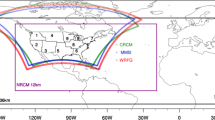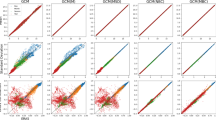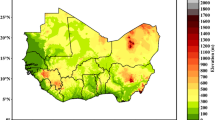Abstract
An accurate description of changes in extreme rainfall events requires high resolution simulations. Regional climate models (RCMs), where GCM data are used to provide input boundary conditions, are widely used as a way to resolve finer spatial scale phenomena. A problem with this, however, is that the inherent systematic biases within the GCM simulation are transferred to the RCM through the model boundaries. In this work we focus on the impact of bias correction of lateral and lower boundary conditions on simulated extreme rainfall events. Here three bias correction approaches are investigated. In increasing order of complexity, these are corrections for the mean, mean and variance, and the nested bias correction (NBC) approach that also corrects for lag-1 autocorrelations at nested timescales. These corrections are implemented on six-hourly GCM data taken from the GCM simulations which are used to drive the RCM along the RCM lateral boundaries. To evaluate the performance of bias correction on simulation of extreme rainfall events, daily precipitation extremes indices from the World Meteorological Organization (WMO) Expert Team on Climate Risk and Sectoral Climate Indicators (ET-CRSCI) are used. The results show that bias correction on the boundary conditions produce the results in significant improvement in extremes indices. It is clear that sea surface temperature (SST) plays an important role in driving the simulation. The results indicate that within the domain (far from boundaries) the errors in precipitation extremes are strongly dependent on the RCM, with a smaller effect coming from changes in the lateral boundary conditions.










Similar content being viewed by others
References
Adachi SA, Tomita H (2020) Methodology of the constraint condition in dynamical downscaling for regional climate evaluation: a review. J Geophys Rese Atmos 125:e2019JD032166
Alexander L, Herold N (2016) ClimPACT2. Indices and software. A document prepared on behalf of The Commission for Climatology (CCI) Expert Team on Sector-Specific Climate Indices (ET-SCI), 46 pp
Alexander LV, Zhang X, Peterson TC, Caesar J, Gleason B, Klein Tank AMG, Haylock M, Collins D, Trewin B, Rahimzadeh F, Tagipour A, Rupa Kumar K, Revadekar J, Griffiths G, Vincent L, Stephenson DB, Burn J, Aguilar E, Brunet M, Taylor M, New M, Zhai P, Rusticucci M, Vazquez-Aguirre JL (2006) Global observed changes in daily climate extremes of temperature and precipitation. J Geophys Res 111:1–22
Bruyere CL, Done JM, Holland GJ, Fredrick S (2014) Bias corrections of global models for regional climate simulations of high-impact weather. Clim Dyn 43:1847–1856
Caldwell P, Chin HNS, Bader DC, Bala G (2009) Evaluation of a WRF dynamical downscaling simulation over California. Clim Change 95:499–521
Cannon AJ, Sobie SR, Murdock TQ (2015) Bias Correction of GCM precipitation by quantile mapping: how well do methods preserve changes in quantiles and extremes? J Clim 28:6938–6959
Cattiaux J, Douville H, Peings Y (2013) European temperatures in CMIP5: origins of present-day biases and future uncertainties. Clim Dyn 41:2889–2907
Diffenbaugh NS, Pal JS, Trapp RJ, Giorgi F (2005) Fine-scale processes regulate the response of extreme events to global climate change. Proc Natl Acad Sci USA 102:15774–15778
Di Luca A, Evans JP, Pepler AS, Alexander LV, Argüeso D (2016) Evaluating the representation of Australian East Coast Lows in a regional climate model ensemble. J South Hemisphere Earth Syst Sci 66:108–124
Dudhia J (1989) Numerical study of convection observed during the winter monsoon experiment using a mesoscale two-dimensional model. J Atmos Sci 46:3077–3107
Evans JP, McCabe MF (2010) Regional climate simulation over Australia’s Murray–Darling basin: a multitemporal assessment. J Geophys Res Atmos 115:1–15
Evans JP, Ekstrom M, Ji F (2012) Evaluating the performance of a WRF physics ensemble over South-East Australia. Clim Dyn 39:1241–1258
Gutowski WJ, Ullrich PA, Hall A, Leung LR, O’Brien TA, Patricola CM, Arritt RW, Bukovsky MS, Calvin KV, Feng Z, Jones AD, Kooperman GJ, Monier E, Pritchard MS, Pryor SC, Qian Y, Rhoades AM, Roberts AF, Sakaguchi K, Urban N, Zarzycki C (2020) The Ongoing need for high-resolution regional climate models: process understanding and stakeholder information. Bull Am Meteorol Soc 101:E664–E683
Janjić ZI (1994) The step-mountain eta coordinate model: further developments of the convection, viscous sublayer, and turbulence closure schemes. Mon Weather Rev 122:927–945
John VO, Soden BJ (2007) Temperature and humidity biases in global climate models and their impact on climate feedbacks. Geophys Res Lett 34:L18704
Johnson F, Sharma A (2012) A nesting model for bias correction of variability at multiple time scales in general circulation model precipitation simulations. Water Resour Res 48:W01504
Jones D, Wang W, Fawcett R (2009) High-quality spatial climate data-sets for Australia. Aust Meteorol Oceanogr J 58:233–248
Kim S, Eghdamirad S, Sharma A, Kim JH (2020) Quantification of uncertainty in projections of extreme daily precipitation. Earth Space Sci 7:e2019EA001052
Leung LR, Qian Y (2009) Atmospheric rivers induced heavy precipitation and flooding in the western US simulated by the WRF regional climate model. Geophys Res Lett 36:L03820
Li J, Sharma A, Evans J, Johnson F (2018) Addressing the mischaracterization of extreme rainfall in regional climate model simulations—a synoptic pattern based bias correction approach. J Hydrol 556:901–912
Lim K-SS, Hong S-Y (2010) Development of an effective double-moment cloud microphysics scheme with prognostic cloud condensation nuclei (CCN) for weather and climate models. Mon Weather Rev 138:1587–1612
Meehl GA, Covey C, Delworth T, Latif M, McAvaney B, Mitchell JFB, Stouffer RJ, Taylor KE (2007) The WCRP CMIP3 multimodel dataset—a new era in climate change research. Bull Am Meteorol Soc 88:1383–1394
Mehrotra R, Sharma A (2015) Correcting for systematic biases in multiple raw GCM variables across a range of timescales. J Hydrol 520:214–223
Mehrotra R, Sharma A (2016) A multivariate quantile-matching bias correction approach with auto- and cross-dependence across multiple time scales: implications for downscaling. J Clim 29:3519–3539
Mehrotra R, Johnson F, Sharma A (2018) A software toolkit for correcting systematic biases in climate model simulations. Environ Model Softw 104:130–152
Mlawer EJ, Taubman SJ, Brown PD, Iacono MJ, Clough SA (1997) Radiative transfer for inhomogeneous atmospheres: RRTM, a validated correlated-k model for the longwave. J Geophys Res Atmos 102:16663–16682
Moalafhi DB, Evans JP, Sharma A (2016) Evaluating global reanalysis datasets for provision of boundary conditions in regional climate modelling. Clim Dyn 47:2727–2745
Moalafhi DB, Sharma A, Evans JP, Mehrotra R, Rocheta E (2017) Impact of bias-corrected reanalysis-derived lateral boundary conditions on WRF simulations. J Adv Model Earth Syst 9:1828–1846
Rocheta E, Sugiyanto M, Johnson F, Evans J, Sharma A (2014) How well do general circulation models represent low-frequency rainfall variability? Water Resour Res 50:2108–2123
Rocheta E, Evans JP, Sharma A (2017) Can bias correction of regional climate model lateral boundary conditions improve low-frequency rainfall variability? J Clim 30:9785–9806
Rocheta E, Evans JP, Sharma A (2020) Correcting lateral boundary biases in regional climate modeling—the effect of the relaxation zone. Clim Dyn. https://doi.org/10.1007/s00382-020-05393-1
Rojas R, Feyen L, Dosio A, Bavera D (2011) Improving pan-European hydrological simulation of extreme events through statistical bias correction of RCM-driven climate simulations. Hydrol Earth Syst Sci 15:2599–2620
Roxy M (2014) Sensitivity of precipitation to sea surface temperature over the tropical summer monsoon region—and its quantification. Clim Dyn 43:1159–1169
Seo SB, Kim Y-O, Kim Y, Eum H-I (2018) Selecting climate change scenarios for regional hydrologic impact studies based on climate extremes indices. Clim Dyn 52:1595–1611
Shiferaw A, Tadesse T, Rowe C, Oglesby R (2018) Precipitation extremes in dynamically downscaled climate scenarios over the Greater Horn of Africa. Atmosphere 9:112
Sillmann J, Kharin VV, Zwiers FW, Zhang X, Bronaugh D (2013) Climate extremes indices in the CMIP5 multimodel ensemble: part 2. Future climate projections. J Geophys Res Atmos 118:2473–2493
Singleton A, Toumi R (2013) Super-Clausius–Clapeyron scaling of rainfall in a model squall line. Q J R Meteorol Soc 139:334–339
Skamarock WC, Klemp JB, Dudhia J, Gill DO, Barker DM, Duda MG, Huang X-Y, Wang W, Powers JG (2008) A description of the advanced research WRF version 3, NCAR technical note. National Center for Atmospheric Research, Boulder
Srikanthan R, Pegram GGS (2009) A nested multisite daily rainfall stochastic generation model. J Hydrol 371:142–153
Tewari M, Chen F, Wang W, Dudhia J, Lemone MA, Mitchell KE, Ek M, Gayno G, Wegiel JW, Cuenca R (2004) Implementation and verification of the unified NOAH land surface model in the WRFmodel. In: 20th conference on weather analysis and forecasting/16th conference on numerical weather prediction, pp 11–15
Trenberth KE, Shea DJ (2005) Relationships between precipitation and surface temperature. Geophys Res Lett 32:L14703
Wang C, Zhang L, Lee S-K, Wu L, Mechoso CR (2014) A global perspective on CMIP5 climate model biases. Nat Clim Change 4:201–205
Wentz FJ, Schabel M (2000) Precise climate monitoring using complementary satellite data sets. Nature 403:414
Xu ZF, Yang ZL (2012) An improved dynamical downscaling method with GCM bias corrections and its validation with 30 years of climate simulations. J Clim 25:6271–6286
Acknowledgements
Youngil Kim is supported by the UNSW Scientia PhD Scholarship Scheme. ERA-I data was made available by the European Centre for Medium-Range Weather Forecasts (ECMWF) online archive catalogue. This work was undertaken with the resources provided by the National Computational Infrastructure (NCI) systems at the Australian National University through the Merit Allocation Scheme. The observed rainfall data was obtained from the Australian Water Availability Project (AWAP) Team and CSIRO Marine and Atmospheric Research (CMAR).
Author information
Authors and Affiliations
Corresponding author
Additional information
Publisher's Note
Springer Nature remains neutral with regard to jurisdictional claims in published maps and institutional affiliations.
Electronic supplementary material
Below is the link to the electronic supplementary material.
Rights and permissions
About this article
Cite this article
Kim, Y., Rocheta, E., Evans, J.P. et al. Impact of bias correction of regional climate model boundary conditions on the simulation of precipitation extremes. Clim Dyn 55, 3507–3526 (2020). https://doi.org/10.1007/s00382-020-05462-5
Received:
Accepted:
Published:
Issue Date:
DOI: https://doi.org/10.1007/s00382-020-05462-5




